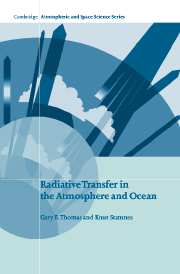Book contents
- Frontmatter
- Contents
- List of Illustrations
- Preface
- Acknowledgments
- Chapter 1 Basic Properties of Radiation, Atmospheres, and Oceans
- Chapter 2 Basic State Variables and the Radiative Transfer Equation
- Chapter 3 Basic Scattering Processes
- Chapter 4 Absorption by Solid, Aqueous, and Gaseous Media
- Chapter 5 Principles of Radiative Transfer
- Chapter 6 Formulation of Radiative Transfer Problems
- Chapter 7 Approximate Solutions of Prototype Problems
- Chapter 8 Accurate Numerical Solutions of Prototype Problems
- Chapter 9 Shortwave Radiative Transfer
- Chapter 10 Transmission in Spectrally Complex Media
- Chapter 11 Radiative Transfer in Nongray Media
- Chapter 12 The Role of Radiation in Climate
- Appendices
- A Nomenclature: Glossary of Symbols
- B Physical Constants
- C Model Atmospheres
- D Ocean Optics Nomenclature
- E Reflectance and Transmittance at an Interface
- Index
D - Ocean Optics Nomenclature
Published online by Cambridge University Press: 18 December 2009
- Frontmatter
- Contents
- List of Illustrations
- Preface
- Acknowledgments
- Chapter 1 Basic Properties of Radiation, Atmospheres, and Oceans
- Chapter 2 Basic State Variables and the Radiative Transfer Equation
- Chapter 3 Basic Scattering Processes
- Chapter 4 Absorption by Solid, Aqueous, and Gaseous Media
- Chapter 5 Principles of Radiative Transfer
- Chapter 6 Formulation of Radiative Transfer Problems
- Chapter 7 Approximate Solutions of Prototype Problems
- Chapter 8 Accurate Numerical Solutions of Prototype Problems
- Chapter 9 Shortwave Radiative Transfer
- Chapter 10 Transmission in Spectrally Complex Media
- Chapter 11 Radiative Transfer in Nongray Media
- Chapter 12 The Role of Radiation in Climate
- Appendices
- A Nomenclature: Glossary of Symbols
- B Physical Constants
- C Model Atmospheres
- D Ocean Optics Nomenclature
- E Reflectance and Transmittance at an Interface
- Index
Summary
Radiative transfer in the ocean occupies a central role in physical oceanography: Light provides the energy that powers primary productivity in the ocean; light diffusely reflected by the ocean provides the signal for the remote sensing of subsurface constituent concentrations; light absorbed by the water heats the ocean's surface layer; light absorbed by chemical species, particularly dissolved organics, provides energy for their breakup; and the rate at which light extinction varies with depth provides an estimate of planktonic activity.
From the above, it is clear that ocean optics is concerned with the distribution of visible light with angle, depth, and wavelength. Infrared radiation is important only for surface cooling, since the mean free path is very small (the opacity of water in the infrared is very high). Unfortunately the absorption and scattering properties of water are usually poorly known, because of the great variety of suspended particulates that occur in nature. In addition, the measurement capabilities are not yet sufficiently accurate to test the predictions of radiative transfer theory. Consequently, mathematically accurate solutions to the radiative transfer equation are not usually needed, although recently Monte Carlo techniques have become popular in the ocean optics literature. Approximate solutions are usually adequate, particularly when comparing with measurements made at great depth, where asymptotic solutions become valid.
Ocean optics developed only in the past fifty years, although some pioneering work was done by Petersson and colleagues in the 1930s.
- Type
- Chapter
- Information
- Radiative Transfer in the Atmosphere and Ocean , pp. 503 - 505Publisher: Cambridge University PressPrint publication year: 1999



